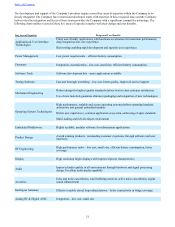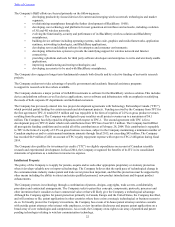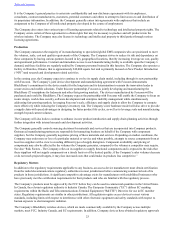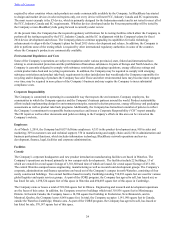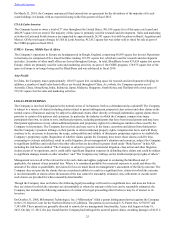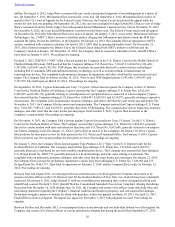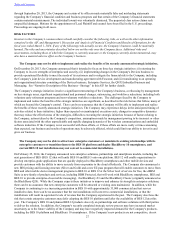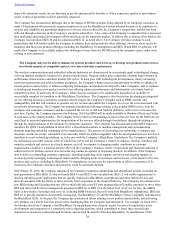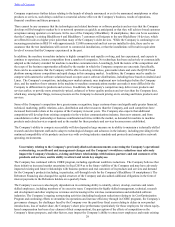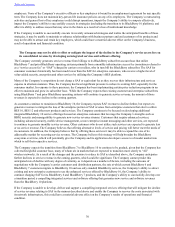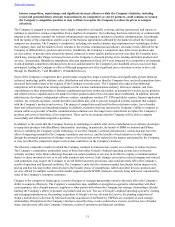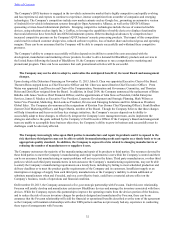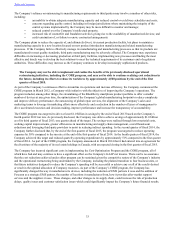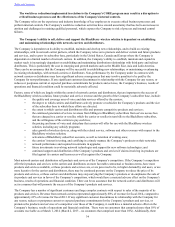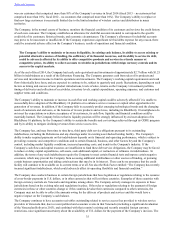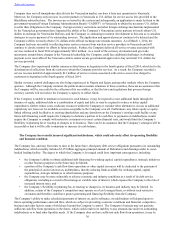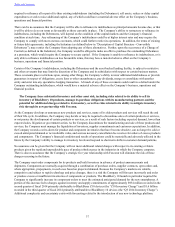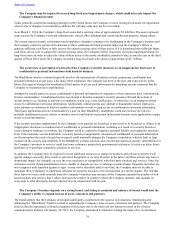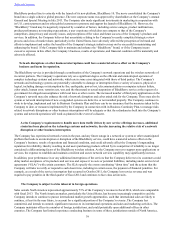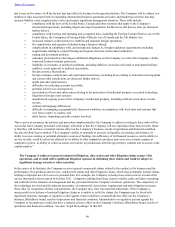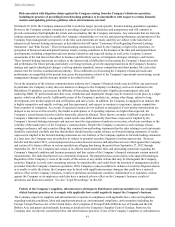Blackberry 2014 Annual Report Download - page 39
Download and view the complete annual report
Please find page 39 of the 2014 Blackberry annual report below. You can navigate through the pages in the report by either clicking on the pages listed below, or by using the keyword search tool below to find specific information within the annual report.
31
Intense competition, rapid change and significant strategic alliances within the Company’s industry, including
recent and potential future strategic transactions by its competitors or carrier partners, could continue to weaken
the Company’s competitive position or may continue to require the Company to reduce its prices to compete
effectively.
The Company is engaged in an industry that is highly competitive and rapidly evolving, and has experienced, and expects to
continue to experience, intense competition from a number of companies. No technology has been exclusively or commercially
adopted as the industry standard for wireless communication, messaging or machine to machine communication. Accordingly,
both the nature of the competition and the scope of the business opportunities afforded by the market in which the Company
competes are uncertain. The Company’s competitors, including new market entrants, may implement new technologies before
the Company does, and the number of new entrants in the wireless communications industry can make it more difficult for the
Company to differentiate its products and services. In addition, the Company’s competitors may deliver new products and
services earlier, or provide more attractively-priced, enhanced or better quality products and services than the Company does,
which may, among other things, increase pressure on the Company to discount pricing on its existing and future products and
services. In particular, BlackBerry smartphone sales and shipments in fiscal 2014 were impacted by a competitive environment
in which multiple competitors introduced new devices and demand for the Company's new handheld devices was lower than
anticipated, leading the Company to offer sell-through programs as well as significant price reductions in order to drive sell-
through for BlackBerry 7 and BlackBerry 10 handheld devices.
Some of the Company’s competitors have greater name recognition, larger customer bases and significantly greater financial,
technical, marketing, public relations, sales, distribution and other resources than the Company does, and such competitors have
increased their market share at the expense of the Company in recent years. The Company also expects that additional
competition will develop from existing companies in the wireless communications industry, from new entrants, and from
consolidation or other partnership or business combination activities within the market, as demand for wireless access products
and related services expands and as the market for these products and services becomes more established. In addition, network
infrastructure developers, independent software vendors, smartphone vendors, PC, PDA and tablet vendors, Internet application
vendors, key network operators, content providers and others may seek to provide integrated wireless solutions that compete
with the Company’s products and services. The impact of competition could result in fewer customer orders, loss of market
share and reduced gross and operating margins. In addition, customers that may question the Company’s ability to compete or
remain viable as a provider of mobile communications solutions over the longer term could decide to replace the Company’s
products and services with those of its competitors. There can be no assurance that the Company will be able to compete
successfully and withstand competitive pressures.
In addition, to the extent that the Company licenses its technology to enable other device manufacturers or software developers
to equip their products with BlackBerry functionality (including, in particular, the launch of BBM on Android and iPhone
devices), including the Company’s push technology, or use the Company’s network infrastructure, such action may have the
effect of impacting demand for the Company’s products and services, and the benefits of such initiatives to the Company
through the potential generation of alternate sources of revenue may not be realized in the manner anticipated by the Company,
or may not offset the competitive impact such actions could have on the Company’s business.
The intensely competitive market in which the Company conducts its business may require it to continue to reduce its prices.
The Company’s competitors, particularly some of those that utilize Google’s Android operating system, have in the past,
currently and may in the future offer deep discounts on certain products or services in an effort to capture or maintain market
share, to reduce inventory levels or to sell other products and services. Such changes can result in reduced margins and reduced
cash generation, may require the Company to record further inventory provisions, and could adversely affect the Company’s
results of operation and financial condition. The Company’s entry into the consumer market has already had an impact on its
pricing and this risk may further intensify due to the broader choice of smartphones, tablets and other devices, products and
services offered by multiple vendors in this market segment and the BYOD strategies currently being utilized or considered by
some of the Company’s enterprise customers.
Changes in the competitive landscape as a result of mergers or strategic partnerships can also adversely affect the Company’s
ability to compete effectively. The Company’s competitors may establish or strengthen co-operative relationships with their
carrier partners, sales channel partners, suppliers or other parties with whom the Company has strategic relationships, thereby
limiting the Company’s ability to promote its products and services. The use of Google’s Android operating system by existing
and emerging manufacturers, the pending acquisition of Google’s devices division by Lenovo, the pending acquisition of
Nokia’s mobile devices division by Microsoft and the acquisition of AirWatch by VMWare are examples of such strategic
relationships. Disruptions in the Company’s business caused by these events could reduce revenue, result in a loss of market
share, and adversely affect the Company’s business, results of operations and financial condition.
Table of Contents


